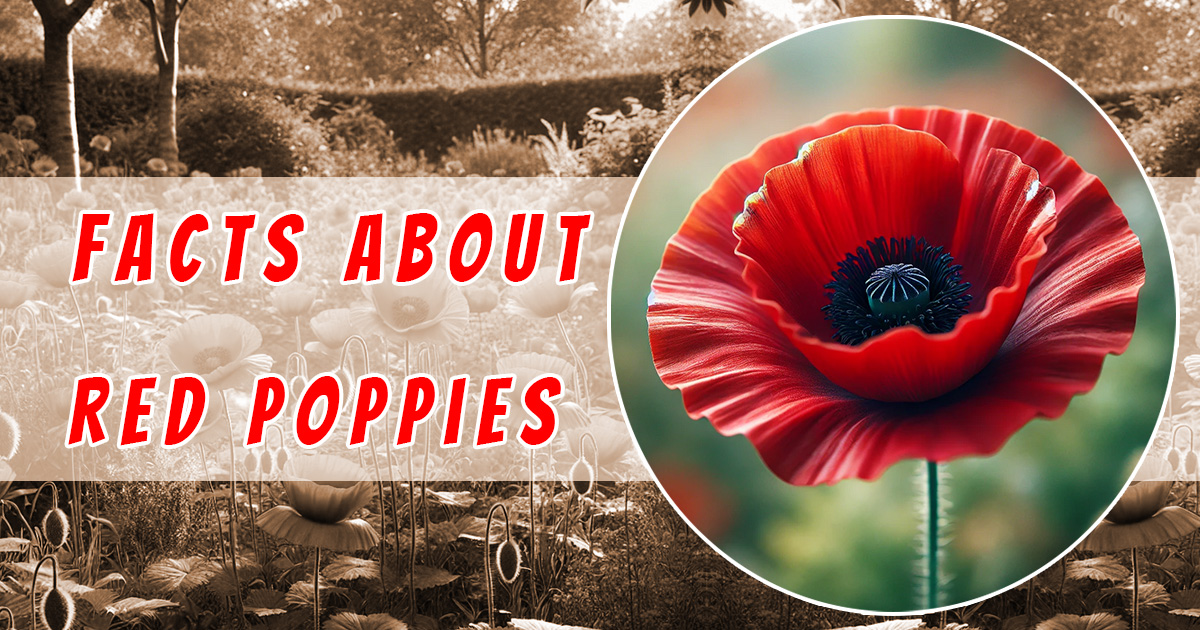Introduction
Red poppies are not just beautiful flowers that grace gardens and fields—they carry a deep historical and cultural significance, especially in relation to remembrance and art. Their vibrant red petals make them an eye-catching addition to any landscape, and their symbolism connects them to themes of sacrifice, hope, and beauty. In this blog post, we will explore everything you need to know about red poppies, including their history, how to grow them in your garden, their appearance in art and culture, and the different varieties you can find around the world.
What Do Red Poppies Symbolize?
The History of Red Poppies in Remembrance
The symbolism of red poppy has roots in World War I, where they became a symbol of remembrance for fallen soldiers. This association originated from the famous war poem “In Flanders Fields” by Lieutenant Colonel John McCrae, which depicted the red poppies growing among soldiers’ graves in Flanders, Belgium. The poem immortalized the red poppy as a reminder of the sacrifice made by soldiers and the hope for peace after war.
Since then, red poppies have been worn annually on Remembrance Day (also known as Poppy Day or Veterans Day) in many countries, particularly in the UK, Canada, and other Commonwealth nations. The red poppy has become a global symbol of respect, gratitude, and remembrance for those who served in wars, making it much more than just a flower.
As a Symbol in Art and Culture
Red poppies have also found their place in art and culture, representing a variety of emotions such as beauty, life, and sacrifice. Painters like Georgia O’Keeffe and Vincent van Gogh frequently incorporated red poppy into their artwork, using their vivid color to evoke strong emotions and deeper meanings.
In literature, its often appear as metaphors for loss or renewal, further solidifying their place in both historic and modern culture. From poems to paintings, they have become an enduring symbol in the world of fine arts, transcending their role as simple garden flowers.
For more unique gardening ideas, such as growing colorful fruits, check out our guide on Purple Watermelon.
Growing Red Poppies in Your Garden
Planting from Seeds
Growing these poppies from seeds is a rewarding way to bring a splash of vibrant color to your garden. Poppies are relatively easy to grow, making them a popular choice for gardeners, even those with limited experience. Red poppies thrive in well-drained soil and sunny locations, and they are hardy enough to withstand different climates.
To plant red poppy seeds, scatter them on the soil’s surface in early spring or late fall, as they prefer cooler weather for germination. There’s no need to cover the seeds with soil—just lightly press them into the ground and water gently. In about 7-14 days, you should start to see seedlings sprouting. They are perfect for wildflower gardens, adding a natural, untamed look with their delicate petals and tall stems.
Caring for Red Poppies Throughout the Year
Once established, they require minimal care. These hardy flowers are relatively drought-tolerant, but they benefit from regular watering during the growing season. However, overwatering can cause root rot, so it’s important to let the soil dry between waterings.
Deadheading, or removing spent flowers, can encourage continuous blooming. Red poppy generally bloom from late spring to early summer, but with proper care, some varieties can flower again later in the season. These flowers also tend to self-seed, meaning they can return year after year without the need for replanting.
Types of Red Poppies
Common Varieties:
While the term red poppy often refers to the iconic Papaver rhoeas, also known as the Flanders poppy or corn poppy, there are several varieties of red poppies that vary in size, color intensity, and growing conditions.
- Papaver rhoeas (Flanders Poppy): The most well-known variety, associated with Remembrance Day.
- Papaver somniferum (Opium Poppy): Though typically associated with its medicinal uses, opium poppies also produce beautiful red flowers and are commonly grown in gardens for their ornamental value.
- Papaver orientale (Oriental Poppy): A larger species, Oriental poppies are known for their bold red flowers with black centers, making them a dramatic addition to gardens.
Each of these varieties has its own unique characteristics, but they all share the iconic red color that makes poppies so recognizable and beloved.
Wild Red Poppies vs. Cultivated Varieties
Wild red poppies can be found growing naturally in fields and meadows across Europe, Asia, and parts of North America. These wild varieties are typically smaller and less uniform in appearance than cultivated poppies. They thrive in disturbed soils, which is why they are often seen blooming in fields, roadsides, and even battlefields.
Cultivated red poppies, on the other hand, are bred for their larger flowers and more vibrant colors. These varieties are perfect for home gardens, as they are designed to produce more consistent blooms and are often more resistant to pests and diseases.
Red Poppies in Art, Literature, and Culture
Famous Paintings and Poetry Featuring
Red poppies have been a favored subject in art for centuries. The flower’s delicate yet striking form has inspired countless artists to capture its beauty. Painters like Georgia O’Keeffe frequently used poppies in their work (Georgia O’Keeffe Museum), emphasizing their vibrant color against contrasting backgrounds. Vincent van Gogh painted red poppies in several works, emphasizing their vibrant color against contrasting backgrounds. Likewise, Georgia O’Keeffe, known for her close-up depictions of flowers, also portrayed red poppies in her iconic paintings.
In poetry, they have often been used as symbols of life, death, and remembrance. John McCrae’s famous poem “In Flanders Fields” is perhaps the most notable literary work to feature the red poppy as a symbol of the fallen soldiers of World War I, forever linking the flower to themes of loss and sacrifice.
Red Poppies in Modern Pop Culture
In modern pop culture, they appear in fashion, film, and design. They are used as motifs on clothing, jewelry, and even home decor, thanks to their bold color and symbolic meaning. They have also been featured in movies and TV shows as symbols of memory and resilience, making them a versatile cultural symbol.
The widespread use of red poppies in both historical and modern contexts ensures that their symbolic significance continues to thrive today.
How to Buy and Plant Red Poppy Seeds
Where to Buy Red Poppy Seeds
Finding red poppy seeds is relatively easy, as they are widely available at garden centers and online retailers. If you’re looking for a specific variety, such as the Flanders poppy or Oriental poppy, it’s best to purchase from specialty seed retailers that offer a wide selection of wildflower and ornamental plant seeds.
Many online platforms, such as Amazon, Etsy, and specialized gardening websites, sell red poppy seeds. Always check reviews and product details to ensure that the seeds you’re purchasing are of high quality and suited to your growing conditions.
Tips for Planting Red Poppy Seeds
Planting red poppy seeds is a straightforward process, but a few tips can help ensure success:
- Sow in early spring or late fall for the best results, as poppy seeds need cooler temperatures to germinate.
- Do not cover the seeds—simply scatter them on the soil’s surface and lightly press them in.
- Water gently after planting, but avoid overwatering to prevent washing the seeds away or causing them to rot.
- Once established, red poppies require little care and often self-seed, meaning they’ll return the following year.
By following these simple steps, you can enjoy a vibrant display of red poppies in your garden year after year.
How to Harvest Red Poppies
If you’re growing red poppies in your garden and want to harvest them for decorative purposes or to collect seeds, it’s essential to do so when the flower heads are fully mature but before they start to shed petals. Gently cut the flower stems and hang them upside down in a cool, dry place to preserve them.
Red Poppies and Pollinators
Red poppies are not only beautiful but also beneficial for pollinators like bees and butterflies. Their bright red petals and rich pollen supply attract pollinators, helping support local ecosystems. By planting red poppies in your garden, you contribute to maintaining healthy pollinator populations, which are essential for a thriving environment.
For more useful blogs visit out homepage myreadmagazine.com
FAQs About Red Poppies
Can red poppies grow in containers?
Yes, red poppies can be grown in containers, provided the container is large enough to accommodate their root system and the soil is well-draining. Place the container in a sunny location, as poppies thrive in full sun. Water regularly, but be sure to allow the soil to dry out between waterings to prevent root rot.
What is the best time to plant red poppies?
The best time to plant red poppy seeds is in early spring or late fall. Poppies prefer cooler temperatures for germination, so these seasons provide the ideal conditions for starting the seeds.
Are red poppies poisonous to pets?
Yes, certain varieties of red poppies, particularly Papaver somniferum (Opium Poppy), can be toxic to pets if ingested. If you have pets that like to chew on plants, it’s best to keep them away from red poppies or opt for non-toxic varieties.
Conclusion
Red poppies are much more than just striking flowers—they are symbols of remembrance, resilience, and beauty. Whether you’re honoring fallen soldiers, adding vibrant color to your garden, or exploring their place in art and culture, red poppies have a rich history that continues to inspire. With the right care and attention, you can grow your own beautiful red poppies and enjoy their blooms for years to come.




